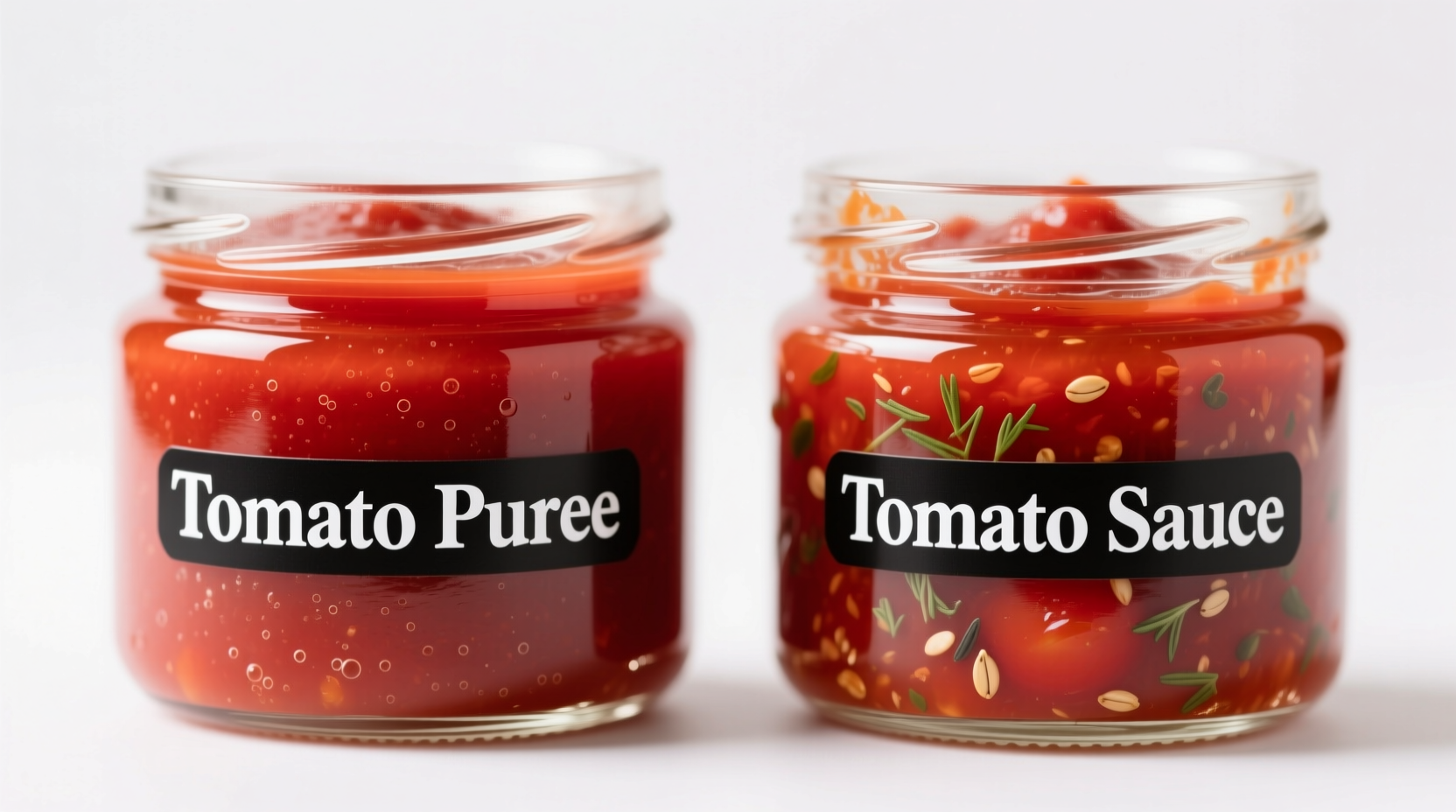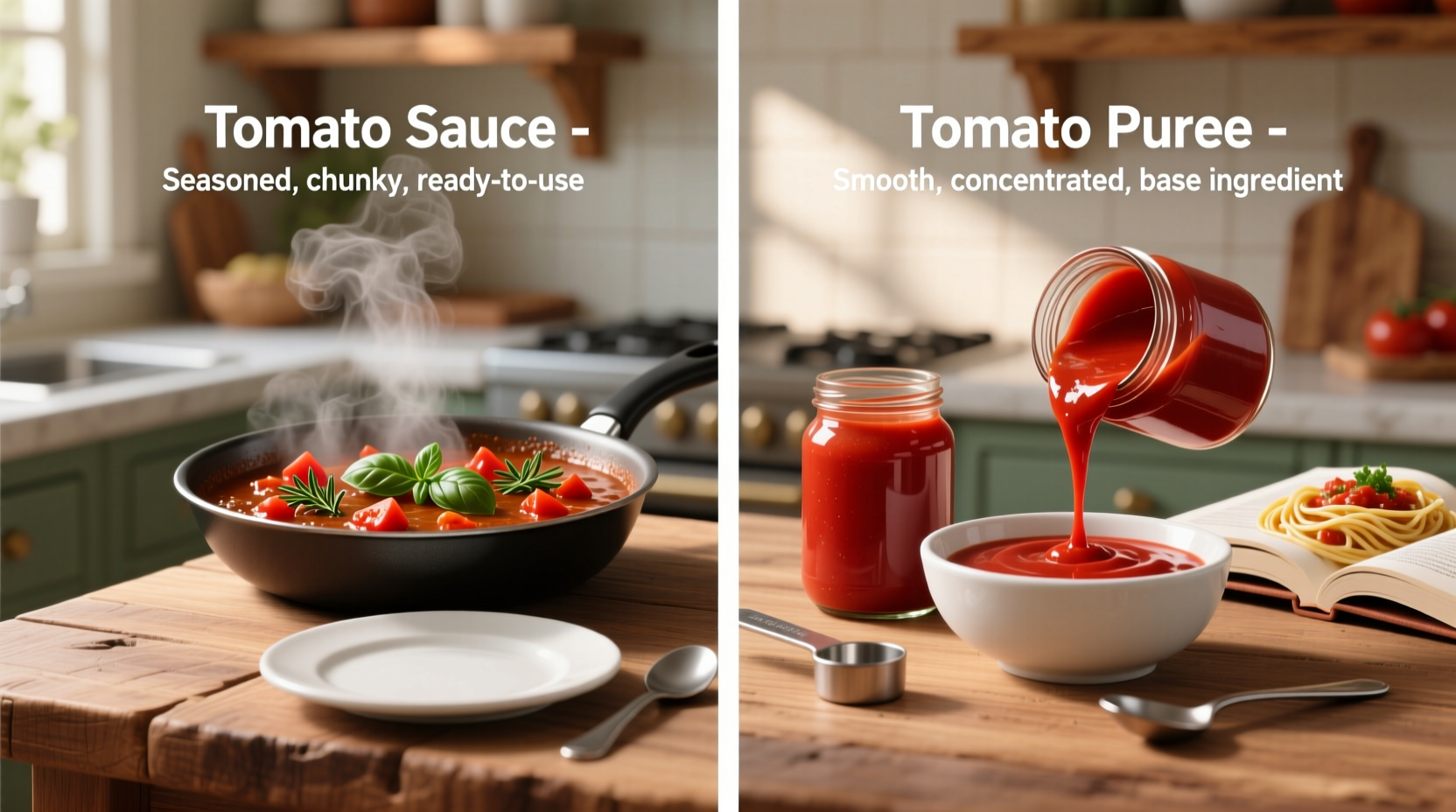Ever stood in the grocery aisle confused about whether to grab tomato puree or tomato sauce for your recipe? You're not alone. Understanding the difference between tomato sauce and tomato puree is crucial for achieving perfect results in your cooking. This guide cuts through the confusion with clear, chef-tested insights you can trust immediately.
What Exactly Is Tomato Puree?
Tomato puree represents the essence of tomatoes in their most concentrated form. According to the U.S. Food and Drug Administration, tomato puree must contain 8-24% tomato solids with no added seasonings or ingredients. It's created by cooking ripe tomatoes, removing skins and seeds, then blending the flesh into a smooth, velvety consistency.
This unseasoned base ingredient serves as the foundation for countless recipes where you want pure tomato flavor without competing flavors. Professional chefs like those at the Culinary Institute of America emphasize that tomato puree's neutral profile makes it ideal when you need to control seasoning precisely.
Understanding Commercial Tomato Sauce
Tomato sauce, by contrast, is a ready-to-use product that already contains seasonings. The FDA defines commercial tomato sauce as having 6-8% tomato solids along with added ingredients like onions, garlic, herbs, and sometimes sugar. Unlike puree, sauce has been partially cooked and seasoned for immediate use in dishes.
When examining store-bought options, you'll notice significant variation in quality. A 2023 analysis by Food Network's Healthy Eats revealed that premium tomato sauces contain recognizable whole food ingredients, while lower-quality options often include preservatives and artificial flavors that compromise freshness.
| Characteristic | Tomato Puree | Tomato Sauce |
|---|---|---|
| Tomato Solids | 8-24% | 6-8% |
| Added Ingredients | None | Herbs, spices, sometimes sugar |
| Texture | Thick, smooth paste | Thinner, sometimes slightly chunky |
| Cooking Stage | Raw concentrate | Partially cooked |
| Primary Use | Recipe base | Ready-to-use component |
When Substitution Works (and When It Doesn't)
Understanding the tomato sauce vs tomato puree difference becomes critical when substituting one for the other. While you can dilute puree with water (1 part puree to 1 part water) to approximate tomato sauce, the reverse substitution rarely works well.
Food science explains why: Adding puree to sauce creates an overly thick consistency that requires additional liquid, which then dilutes the carefully balanced seasonings. Culinary expert Antonio Rodriguez notes, "I've seen home cooks ruin perfectly good marinara by adding tomato puree without adjusting other ingredients. The acid balance gets completely thrown off."
Practical Application Guide
Knowing what is the difference between tomato sauce and tomato puree helps you choose the right product for your cooking needs:
- Use tomato puree when: Making your own sauces from scratch, creating pizza sauce, or needing a neutral tomato base where you control all seasonings
- Choose tomato sauce when: Preparing quick pasta dishes, soups, or casseroles where time matters and you want built-in flavor
- Avoid substituting when: Following precise baking recipes, making delicate sauces, or creating dishes where acid balance is critical

Professional Chef Tips for Best Results
Master the difference between canned tomato sauce and tomato puree with these pro techniques:
- Read labels carefully: Some "tomato puree" products actually contain citric acid or calcium chloride as stabilizers
- Concentrate puree: Simmer puree for 10-15 minutes to intensify flavor when making rich sauces
- Balance acidity: If substituting puree for sauce, add 1/4 teaspoon sugar per cup to counter increased acidity
- Storage matters: Transfer unused puree to an airtight container; it keeps for 5 days refrigerated versus 3 days for sauce
Remember that regional variations exist—Italian "passata" differs from American tomato puree, and Mexican "salsa" represents another interpretation of tomato sauce. Always consider your recipe's cultural context when selecting products.
Common Questions Answered
Let's address frequent points of confusion about these essential pantry staples:
Can I use tomato puree instead of tomato sauce in chili?
Yes, but you'll need to dilute one part puree with one part water and add seasonings. Puree provides a stronger tomato flavor foundation, but requires additional spices to match sauce's complexity. For best results, add 1/2 teaspoon garlic powder, 1/4 teaspoon onion powder, and 1/4 teaspoon dried oregano per cup of diluted puree.
Why does tomato puree sometimes separate in the can?
Natural separation occurs because tomato puree contains no stabilizers or thickeners. The liquid (tomato water) rises to the top while solids settle. Simply stir thoroughly before using. This separation actually indicates a purer product without unnecessary additives.
Which has more nutritional value, tomato puree or tomato sauce?
Tomato puree generally contains more concentrated nutrients per serving since it has higher tomato solid content. According to USDA FoodData Central, one-quarter cup of puree provides 22 calories, 5g carbohydrates, and 1.8g fiber, while the same amount of basic tomato sauce offers 20 calories, 4.8g carbohydrates, and 1.2g fiber. However, sauce often contains added garlic and herbs that provide additional phytonutrients.
How can I tell if tomato puree has gone bad?
Check for these signs: bulging cans, leaking containers, mold growth, or an off smell. Once opened, puree should be used within 5 days. Discard if you notice darkening color, separation that doesn't mix back together, or any sour or fermented odor. Properly stored unopened puree maintains quality for 12-18 months.











 浙公网安备
33010002000092号
浙公网安备
33010002000092号 浙B2-20120091-4
浙B2-20120091-4